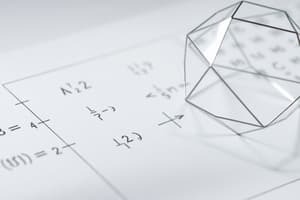Podcast
Questions and Answers
What is the formula to calculate the area of a triangle?
What is the formula to calculate the area of a triangle?
- A = 1/2 * base * height (correct)
- A = base * height / 2
- A = 2 * base * height
- A = base * height
Which of the following best describes the relationship in the Pythagorean theorem?
Which of the following best describes the relationship in the Pythagorean theorem?
- a² - b² = c²
- a + b = c
- a² + b² = c² (correct)
- a² + b² = c
In algebra, what is the purpose of the quadratic formula?
In algebra, what is the purpose of the quadratic formula?
- To determine the roots of quadratic equations (correct)
- To factor quadratic expressions
- To calculate the area under curves
- To find slopes of functions
Which of the following best defines the sine ratio in trigonometry?
Which of the following best defines the sine ratio in trigonometry?
What are the measures of central tendency in statistics?
What are the measures of central tendency in statistics?
In number theory, what does modular arithmetic deal with?
In number theory, what does modular arithmetic deal with?
What does the formula for compound interest calculate?
What does the formula for compound interest calculate?
What is the primary focus of graph theory within discrete mathematics?
What is the primary focus of graph theory within discrete mathematics?
Flashcards are hidden until you start studying
Study Notes
Key Areas of Mathematics
-
Arithmetic
- Basic operations: addition, subtraction, multiplication, division.
- Concepts of prime numbers, factors, and multiples.
-
Algebra
- Variables and constants; expressions and equations.
- Solving linear equations and inequalities.
- Quadratic equations: factoring, completing the square, and using the quadratic formula.
-
Geometry
- Types of angles (acute, obtuse, right).
- Properties of shapes: triangles, quadrilaterals, circles.
- Perimeter, area, and volume calculations.
-
Trigonometry
- Sine, cosine, tangent ratios.
- Right triangle relationships and the Pythagorean theorem.
- Unit circle and radian measure.
-
Calculus
- Limits and continuity.
- Differentiation: rules, applications, and finding slopes.
- Integration: definite and indefinite integrals, area under curves.
-
Statistics
- Measures of central tendency: mean, median, mode.
- Probability concepts and distributions (normal, binomial).
- Data representation: charts, graphs, and tables.
-
Number Theory
- Properties of integers, divisibility rules.
- Modular arithmetic and the concept of congruences.
- Theorems: Euclidean algorithm, Fundamental Theorem of Arithmetic.
-
Discrete Mathematics
- Graph theory: vertices, edges, paths, and circuits.
- Combinatorics: permutations and combinations.
- Logic: propositions, truth tables, and logical operators.
Important Formulas
- Area of a Triangle: A = 1/2 * base * height
- Pythagorean Theorem: a² + b² = c²
- Quadratic Formula: x = (-b ± √(b² - 4ac)) / (2a)
- Compound Interest: A = P(1 + r/n)^(nt)
Study Tips
- Practice regularly with problem sets to reinforce learning.
- Visualize concepts using graphs and diagrams, especially in geometry and calculus.
- Work on past exam papers to familiarize with question formats and time management.
- Form study groups for collaborative learning and problem-solving.
Key Areas of Mathematics
-
Arithmetic
- Involves fundamental operations: addition, subtraction, multiplication, division.
- Understanding prime numbers, factors, and multiples is essential for number theory.
-
Algebra
- Utilizes variables and constants to form expressions and equations.
- Involves solving linear equations and inequalities for finding unknowns.
- Quadratic equations can be factored, solved by completing the square, or approached via the quadratic formula.
-
Geometry
- Includes various angles: acute (less than 90°), obtuse (greater than 90°), right (exactly 90°).
- Studies the properties of shapes such as triangles, quadrilaterals, and circles.
- Calculates perimeter, area, and volume for different geometric figures.
-
Trigonometry
- Focuses on sine, cosine, and tangent ratios for right triangles.
- Includes the Pythagorean theorem to relate the sides of right triangles.
- The unit circle and radian measurement are fundamental concepts for angles.
-
Calculus
- Explores limits and continuity of functions as foundational concepts.
- Differentiation techniques include applying rules and determining slopes of curves.
- Involves integration for calculating areas under curves and finding definite and indefinite integrals.
-
Statistics
- Measures of central tendency: mean (average), median (middle value), mode (most frequent).
- Probability distributions such as normal and binomial are crucial for understanding random variables.
- Data representation through charts, graphs, and tables aids in visualizing statistical findings.
-
Number Theory
- Investigates properties of integers including divisibility rules.
- Modular arithmetic introduces the concept of congruences that simplifies calculations.
- Key theorems include the Euclidean algorithm for finding greatest common divisors and the Fundamental Theorem of Arithmetic regarding prime factorization.
-
Discrete Mathematics
- Graph theory studies the structure of graphs including vertices and edges.
- Combinatorics focuses on counting techniques like permutations and combinations.
- Logic encompasses propositions, truth tables, and logical operations for mathematical reasoning.
Important Formulas
- Area of a Triangle: A = 1/2 * base * height
- Pythagorean Theorem: a² + b² = c²
- Quadratic Formula: x = (-b ± √(b² - 4ac)) / (2a)
- Compound Interest Formula: A = P(1 + r/n)^(nt)
Study Tips
- Regular practice with problem sets reinforces mathematical skills and concepts.
- Visualization techniques using graphs and diagrams can help in understanding complex ideas, particularly in geometry and calculus.
- Reviewing past exam papers enhances familiarity with exam formats and improves time management skills.
- Joining study groups fosters collaborative learning and helps tackle challenging problems together.
Studying That Suits You
Use AI to generate personalized quizzes and flashcards to suit your learning preferences.




